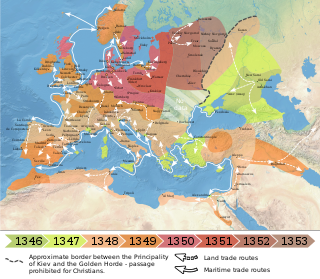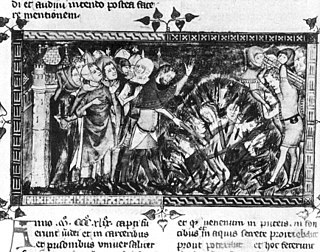 W
WThe Black Death was the deadliest pandemic recorded in human history. The Black Death pandemic resulted in the deaths of up to 75–200 million people in Eurasia and North Africa, peaking in Europe from 1347 to 1351. Plague, the disease, was caused by the bacterium Yersinia pestis. The Y. pestis infection most commonly results in bubonic plague, but can also cause septicaemic or pneumonic plagues.
 W
WThe Black Death was present in the Holy Roman Empire between 1348 and 1351. The Holy Roman Empire, composed of today's Germany, Switzerland, Austria, Belgium and the Netherlands, was, geographically, the largest country in Europe at the time, and the pandemic lasted several years due to the size of the Empire.
 W
WThe Black Death in medieval culture includes the effect of the Black Death (1347–1350) on art and literature throughout the generation that experienced it.
 W
WThe consequences of the Black Death have had both immediate and long-term effects on human population across the world. These include a series of biological, social, economic, political and religious upheavals which had profound effects on the course of world history, especially the History of Europe. Often simply referred to as "The Plague", the Black Death was one of the most devastating pandemics in human history, peaking in Europe between 1348 and 1350 with an estimated one-third of the continent's population ultimately succumbing to the disease. Historians estimate that it reduced the total world population from 475 million to between 350 and 375 million. In most parts of Europe, it took nearly 80 years for population sizes to recover, and in some areas more than 150 years.
 W
WThe Cronaca fiorentina di Marchionne di Coppo Stefani written by Baldassarre Bonaiuti is considered today as one of the best works written on the Black Death in Florence in the year 1348. It is the only known literary work by Bonaiuti. It was written in vulgar Latin. There is no information as to when he may have started his work, but he devoted much time on it in his retirement from about 1378 until his death, a period of seven years.
 W
WThe crucifix of San Marcello is a medieval work of religious art that is venerated in the Oratory of Santissimo Crocifisso of the Church of San Marcello al Corso in Rome. Having survived a fire that destroyed the church in 1519, the crucifix was popularly believed to possess intercessory powers. During an epidemic of plague in 1522 the crucifix was carried in a procession through the city. According to popular belief at the time, the procession caused the plague to leave the neighborhoods through which the crucifix passed, and eventually to die out in Rome.
 W
WThe Black Death was present in Denmark between 1348 and 1350. The Black Death in Denmark is the least known from all the Nordic countries with the exception of Finland.
 W
WThe Black Death was a bubonic plague pandemic, which reached England in June 1348. It was the first and most severe manifestation of the Second Pandemic, caused by Yersinia pestis bacteria. The term Black Death was not used until the late 17th century.
 W
WThe Black Death was present in Sweden between 1350 and 1351. It was a major catastrophe which was said to have killed a third of the population, and Sweden was not to recover fully for three hundred years.
 W
WFlagellants are practitioners of an extreme form of mortification of their own flesh by whipping it with various instruments. Most notably, Flagellantism was a 14th-century movement, consisting of radicals in the Catholic Church. It began as a militant pilgrimage and was later condemned by the Catholic Church as heretical. The followers were noted for including public flagellation in their rituals. This was a common practice during the Black Death, or the Great Plague.
 W
WThe Black Death was present in France between 1347 and 1352. The bubonic plague pandemic known as the Black Death reached France by ship from Italy to Marseille in November 1347, spread through first Southern France and then Northern France and, due to the size of the Kingdom, lasted there several years, as some parts were not affected until the plage was over in others. The Kingdom of France had the largest population of Europe at the time, and the Black Death was a major catastrophe. The Black Death in France was described by eyewitnesses such as Louis Heyligen, Jean de Venette and Gilles Li Muisis. The Black Death migrated from Southern France to Spain, from Eastern France to the Holy Roman Empire, and to England by ship from Gascony.
 W
WThe Black Death was present in the Holy Roman Empire between 1348 and 1351. The Holy Roman Empire, composed of today's Germany, Switzerland, Austria, Belgium and the Netherlands, was, geographically, the largest country in Europe at the time, and the pandemic lasted several years due to the size of the Empire.
 W
WThe Black Death was present in the Holy Roman Empire between 1348 and 1351. The Holy Roman Empire, composed of today's Germany, Switzerland, Austria, Belgium and the Netherlands, was, geographically, the largest country in Europe at the time, and the pandemic lasted several years due to the size of the Empire.
 W
WThe Black Death was present in the Italian states of present-day Italy between 1347 and 1348. Sicily and the Italian Peninsula was the first area in then Catholic Western Europe to be reached by the bubonic plague pandemic known as the Black Death, which reached the region by an Italian ship from the Crimea which landed in Messina in Sicily in October 1347.
 W
WThe Black Death was one of the most devastating pandemics in human history, resulting in the deaths of an estimated 75 to 200 million people in Eurasia and peaking in Eurasia from 1321 to 1353. Its migration followed the sea and land trading routes of the medieval world. This migration has been studied for centuries as an example of how the spread of contagious diseases is impacted by human society and economics.
 W
WThe Black Death was present in the Holy Roman Empire between 1348 and 1351. The Holy Roman Empire, composed of today's Germany, Switzerland, Austria, Belgium and the Netherlands, was, geographically, the largest country in Europe at the time, and the pandemic lasted several years due to the size of the Empire.
 W
WThe Black Death was present in Norway between 1349 and 1350. The Black Death in Norway is more documented than any other Nordic country, but the information is unbalanced and mainly focused on Western Norway.
 W
WThe Black Death persecutions and massacres were a series of violent attacks on Jewish communities falsely blamed for outbreaks of the Black Death in Europe from 1348 to 1351.
 W
WThe Black Death was present in the states of present-day Spain between 1348 and 1350. In the 14th-century, present-day Spain was composed of the Kingdoms of Aragon, Castile and Navarre, and the Emirate of Granada.
 W
WThe Strasbourg massacre occurred on February 14, 1349, when several hundred Jews were publicly burnt to death, and the rest of them expelled from the city as part of the Black Death persecutions.
 W
WThe Black Death was present in Sweden between 1350 and 1351. It was a major catastrophe which was said to have killed a third of the population, and Sweden was not to recover fully for three hundred years.
 W
WThe Black Death was present in the Holy Roman Empire between 1348 and 1351. The Holy Roman Empire, composed of today's Germany, Switzerland, Austria, Belgium and the Netherlands, was, geographically, the largest country in Europe at the time, and the pandemic lasted several years due to the size of the Empire.
 W
WYersinia pestis is a gram-negative, non-motile, rod-shaped, coccobacillus bacterium, without spores. It is a facultative anaerobic organism that can infect humans via the Oriental rat flea. It causes the disease plague, which takes three main forms: pneumonic, septicemic, and bubonic. There may be evidence suggesting Y. pestis originated in Europe in the Cucuteni–Trypillia culture and not in Asia as is more commonly believed.